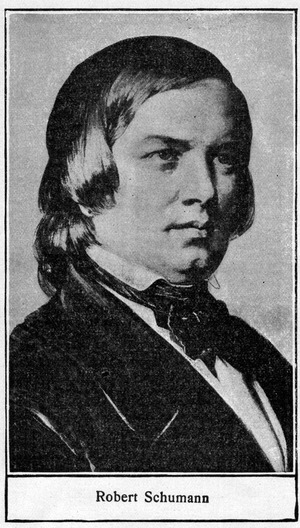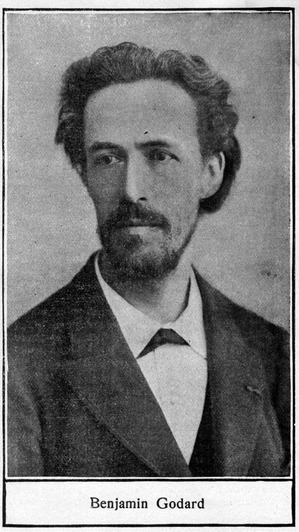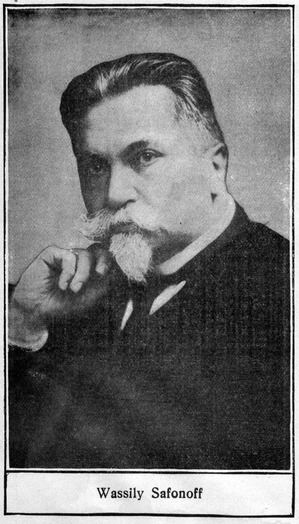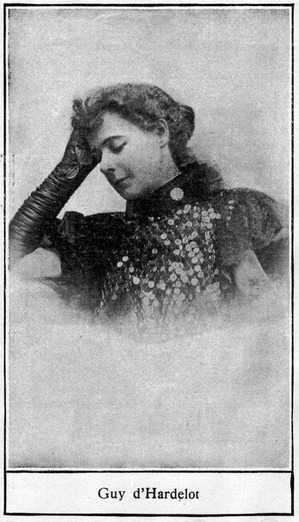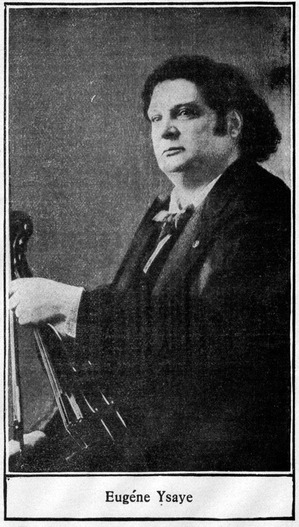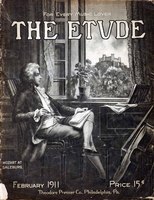(Hoom’-perdink.)
Humperdinck was born at Siegburg, in the Rhine provinces, September 1, 1854. In 1872 he entered. the Cologne Conservatory under Ferdinand Hiller. In 1876 he won a scholarship which enabled him to go to Munich, where he studied with Lachner and later with Rheinberger. He won the Mendelssohn Stiftung (foundation) of Berlin in 1879, and went to Italy, and became acquainted with Wagner in Naples. Wagner invited him to go to Bayreuth, and during 1880-81 Humperdinck assisted in the production of Parsifal. Having won another prize, however, he went again to Southern Europe, traveling through Italy, France and Spain, spending two years in Barcelona teaching at the conservatoire. In 1887 he returned to Cologne, and was appointed professor at the Hoch Conservatory (Frankfort-on-Main) in 1890, and also teacher of harmony at Stockhausen’s Vocal School. By this time he had composed several works for chorus and a Humoreske for orchestra, which enjoyed a vogue in Germany. His chief reputation rests on his opera Haensel und Gretel, which was produced at Weimar, 1893. In 1896 the Kaiser made Humperdinck a Professor and he went to live at Boppard. Four years later, however, he went to Berlin where he was appointed head of a Meister-Schule of composition. Among his other operatic works may be mentioned Dornröschen, Die Königskinder (produced for the first time in New York this season) and Die Heirath wider Willen.
(Shoo’-manh.)
Schumann was born at Zwickau, Saxony, June 8, 1810, and died at Endernich, near Bonn, July 29, 1856. He wrote his first composition in 1817, when he was studying under Kuntsche and Marienkirsche. He studied law at Leipsic in 1828, and a year later he went to Heidelberg. In 1830 he overcame parental opposition and commenced to study piano under Friedrich Wieck. The next year however, he injured his hand and forsook piano playing for composition. In 1834 he founded his famous paper, Neue Zeitschrift für Musik. He lived in Vienna for a while, but finally returned to Leipsic, and in 1840 married Clara Wieck, the daughter of his former teacher, in face of tremendous opposition from her father. This love match is one of the most romantic episodes in musical history. In the year following his wedding he composed over one hundred songs. In 1843 he was appointed professor of pianoforte playing and composition at Leipsic, when the conservatory was opened by Mendelssohn, but gave this up in order to go to Dresden. In 1850 his opera, Genoveva, was produced in Leipsic, but without much success. In 1851 indications of insanity made their appearance. Compositions typical of his genius are the G minor symphony, and the Carnival music for piano. His Traümerei is tremendously popular as a short piece, whilst his songs Widmung and Der Nussbaum are immortal. He was one of the greatest of all composers.
(Go-darh’.)
Godard was born August 18, 1849, at Paris, and died at Cannes, January 10, 1895. He studied at the Paris Conservatoire under Reber (harmony) and Vieuxtemps (violin). He accompanied Vieuxtemps twice to Germany, and also devoted himself to chamber music. He composed music with great facility, and, indeed, his work suffers at times from a lack of careful revision. Nevertheless he gradually obtained recognition. In 1876 his Concerto Romantique was performed at the Concerts Populaires, and other works of large dimensions were also performed at these concerts. In 1878 Godard’s name was bracketed with that of Dubois, the present head of the Conservatoire in Paris, as winner in a musical competition instituted by the municipality of Paris. This composition, a dramatic symphony entitled Tasso, is perhaps his most important work. He also composed other symphonic work, ballets, concertos, and overtures. As a composer of opera he was only moderately successful, the best known of his works being Jocelyn, from which the beautiful Berceuse has become so popular. Godard is probably best known as a writer of salon music, much of which has become extremely popular. Among his piano pieces may be mentioned the second Mazurka, the second Valse, Au Matin, Postilion, En Courant, En Train and Les Hirondelles. Florian’s Song is also very popular in many arrangements.
(Sa-fo’-noff.)
Safonoff was born at Itschóry, Russian Caucasus, February 7, 1852, and is the son of a Russian officer of Cossacks. He was educated at the Lycée Imperial Alexandra, St. Petersburg, and at the St. Petersburg Conservatory of Music. He graduated as Bachelor of Laws, and won the gold medal of the Conservatory, where he studied, 1881- 1885. He was also a pupil of Leschetizky and Zaremba. Safonoff was made professor of the pianoforte at Moscow Conservatory, 1885, and four years later became director of that institution. He retired from that position in 1890, and has since become well known as a conductor, and has acted in that capacity with nearly all the principal orchestras in Europe, including the Philharmonic Orchestras of Berlin, Vienna and Prague, the Lamoreaux Orchestra, of Paris, the London Symphony and the Santa Cecilia, of Rome. In this capacity, of course, he is well known in America, on account of his work with the New York Philharmonic Sociey. (sic) He got most excellent results from this organization, though his audiences were somewhat puzzled by the fact that he never used a baton. As a teacher, Safonoff has earned a very high reputation for himself. He was director of the National Conservatory of Music, in New York, and has numbered many distinguished musicians among his pupils. Perhaps the most notable are Scriabine and Josef Lhévinne.
(dard’-loh.)
Mme. d’Hardelot (Mrs. Rhodes) was born at Chateau d’Hardelot, near Boulogne. This interesting old castle, from which she takes her pen-name, was once occupied by Henry VIII and Anne Boleyn. Her father was English and her mother French. At the age of fifteen she went to Paris, where she studied at the Conservatoire under Maury, and came under the notice of Gounod and Victor Maurel, who were much impressed with her ability. On coming to London she became a pupil of Clarence Lucas. Mme. Calvé has been a good friend to Mme. d’Hardelot, and has done much to bring her songs into notice. Most of her life, Mme. d’Hardelot has been engaged in teaching singing and diction at her home in London, and many of her pupils have attained success. She has been to America, however, and in 1896 toured this country with Mme. Calvé. Her first real success as a composer was won with Because, though her song Sans Toi had previously been favorably received. Among her other successes may be mentioned I Know a Lovely Garden, I Think, I Hid My Love, Dawn, A Bunch of Violets, etc. She has been singularly successful as a writer of songs, in which she combines French delicacy with English solidity. Few women writers have become more popular than has Mme. d’Hardelot, and her success has been won on merit alone. In spite of the help of many friends, it was some time before the public realized that her work possesses high merit.
(ee-zigh’.)
Ysaye was born at Liège, Belgium, July 16, 1858. He studied first with his father, and then with Massart (viola) and Dupuis (harmony) at the conservatory, gaining a second prize with Ovide Musin in 1867. In 1873 he had an opportunity of studying with Wieniawski, and three years later he became a pupil of Vieuxtemps. Vieuxtemps was especially impressed with Ysaye’s style, and besides giving him lessons obtained for him a three years’ subsidy from the government. Ysaye also won for himself the friendship of Hiller, Raff and Clara Schumann. In 1886 he was appointed Violin Professor at the Brussels’ Conservatory, but in 1898 retired on account of his many engagements. He has made very many tours, and has been several times to America. As a violinist he has marked individuality, and has especial faculty for securing variety of “color.” He makes considerable use of the tempo rubato, but though his playing is fiery, it is kept well under control. Ysaye has had many critics, especially in Germany, where his warmth of temperament offended the older school of musicians. Nevertheless, his genius is now fully acknowledged, and he stands with the great ones, Joachim, Wieniawski, Vieuxtemps, Kreisler, Sarasate, etc., differing from these only as they differ from each other. He has used both a Strad and a Guadagnini violin, but now uses a Guarneri. He has been a good friend to younger composers, and to neglected composers of the older school.



